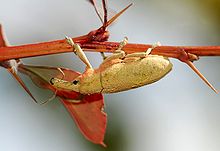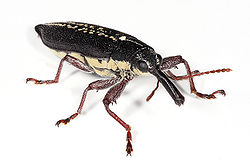- Weevil
-
This article is about the beetles. For other uses, see Weevil (disambiguation).
Weevils 
Lixus angustatus Scientific classification Kingdom: Animalia Phylum: Arthropoda Class: Insecta Order: Coleoptera Suborder: Polyphaga Infraorder: Cucujiformia Superfamily: Curculionoidea
Latreille, 1802Families Anthribidae — fungus weevils
Attelabidae — leaf rolling weevils
Belidae — primitive weevils
Brentidae — straight snout weevils
Caridae
Curculionidae — true weevils
Nemonychidae — pine flower weevilsA weevil is any beetle from the Curculionoidea superfamily. They are usually small, less than 6 millimetres (0.24 in), and herbivorous. There are over 60,000 species in several families, mostly in the family Curculionidae (the true weevils). Some other beetles, although not closely related, bear the name "weevil", such as the biscuit weevil (Stegobium paniceum), which belongs to the family Anobiidae.
Many weevils are damaging to crops. The grain or wheat weevil (Sitophilus granarius) damages stored grain. The boll weevil (Anthonomus grandis) attacks cotton crops. It lays its eggs inside cotton bolls, and the young weevils eat their way out.
Weevils are often found in dry foods including nuts and seeds, cereal and grain products, such as pancake mix. In the domestic setting, they are most likely to be observed when a bag of flour is opened. Their presence is often indicated by the granules of the infested item sticking together in strings, as if caught in a cobweb.
Taxonomy
Because there are so many species and such diversity, the higher classification of weevils is in a state of flux. Weevils are generally divided into two major divisions, the Orthoceri or primitive weevils, and the Gonatoceri or true weevils (Curculionidae). E. C. Zimmerman proposed a third division, the Heteromorphi, for several intermediate forms.[1] Primitive weevils are distinguished by having straight antennae, while true weevils have elbowed (geniculate) antennae. The elbow occurs at the end of the scape (first antennal segment) in true weevils, and the scape is usually much longer than the other antennal segments. Some exceptions occur. Nanophyini are primitive weevils (with very long trochanters) but have long scapes and geniculate antennae. From the true weevils, Gonipterinae and Ramphus have short scapes and little or no elbow.
The most recent classification system to family level was provided by Kuschel,[2] with updates from Marvaldi et al.,[3] and was achieved using phylogenetic analyses. The accepted families are the primitive weevils, Anthribidae, Attelabidae, Belidae, Brentidae, Caridae and Nemonychidae, and the true weevils Curculionidae. Most other weevil families were demoted to subfamilies or tribes. Weevil species radiation was shown to follow steps in plant evolution upon which the weevils feed. Weevils can vary in color from black to light brown.
Some of the features used to distinguish weevil families are:
Labrum visible as separate segment to clypeus Anthribidae, Nemonychidae Antennae elbowed most Curculionidae, Nanophyini (Apioninae) Trochanters (segment between coxae and femora) as long or longer than coxae Apioninae including Nanophyini Fore tibia with comb of setae in apical groove opposite tarsal articulation Belidae Elytra striate (with longitudinal ridges or grooves) Brentidae, Curculionidae, Rhinorhynchinae Rostrum short and broad Anthribidae, some Curculionidae (some Brachycerinae including Ithycerus (New York weevil), Scolytinae and Platypodinae). Maxillary palps long and projecting (visible from above at tip of rostrum) Anthribidae, Nemonychidae Abdominal tergites 6 and 7 without spiracles Caridae Gular suture (on ventral part of head) single not double Attelabidae, Brentidae, Curculionidae. Phylogeny
 A long-nosed weevil, Rhinotia hemistictus, from the family Belidae
A long-nosed weevil, Rhinotia hemistictus, from the family Belidae
A phylogeny of the Curculionoidea based on 18S ribosomal DNA and morphological data is suggested below:[3]
References
- ^ E. C. Zimmerman (1994). Australian weevils (Coleoptera: Curculionidae). Volume 1. Orthoceri: Anthribidae to Attelabidae: the primitive weevils. East Melbourne: CSIRO. pp. 741 pp.
- ^ G. Kuschel (1995). "A phylogenetic classification of Curculionoidea to families and subfamilies". Memoirs of the Entomological Society of Washington 14: 5–33.
- ^ a b A. E. Marvaldi, A. S. Sequeira, C. W. O'Brien & B. D. Farrell (2002). "Molecular and morphological phylogenetics of weevils (Coleoptera, Curculionidae): do niche shifts accompany diversification?". Systematic Biology 51 (5): 761–785. doi:10.1080/10635150290102465. PMID 12396590. http://taylorandfrancis.metapress.com/openurl.asp?genre=article&doi=10.1080/10635150290102465.
- Bright, Donald, E., Bouchard, P. (2008) Coleoptera, Curculionidae, Entiminae. Weevils of Canada and Alaska — Volume 2. Insects and Arachnids of Canada Series, Part 25 Ottawa: NRC Research Press. ISBN 978-0-660-19400-4.
Categories:- Weevils
- Beetles
Wikimedia Foundation. 2010.
